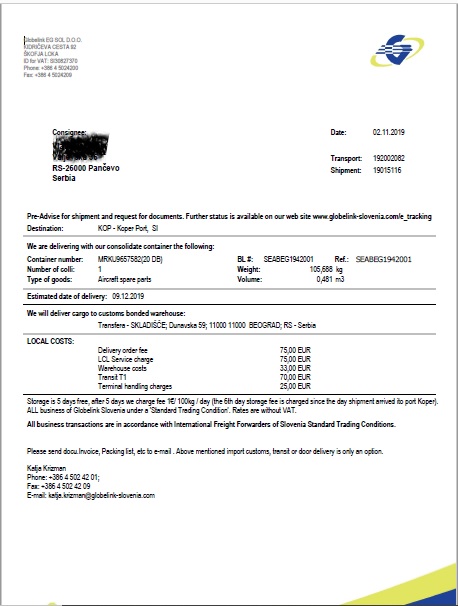|
|
Use the freight calculator above to find accurate international shipping costs from the United States. Select your destination country to receive quick estimates.
Notice of Arrival for Shipping Goods from the USA
When shipping goods internationally from the USA, the Notice of Arrival is a crucial document in the process. It notifies the consignee, the person or company receiving the shipment, that the cargo is about to arrive in their country and outlines the next steps to be taken.
The destination agent of the international ocean freight carrier typically sends this official notice. It includes essential shipment details, such as the cargo's arrival date, where it will be available for pickup, and what documents and fees are required for customs clearance and cargo release.

Why It Matters
Every international shipment comes with destination (local) charges — fees that are not included in your initial U.S. freight quote. These can include:
- Government-related fees, including import duties, VAT, customs clearance, harbor fees, and entry filing by a local customs broker.
- Charges for terminal handling (THC), de-consolidation, warehousing, or storage.
- Additional charges if you opt for door delivery service in the destination country.
These charges must be paid by the consignee, usually before the cargo is released. Payment delays can lead to storage costs or customs penalties.
How You'll Receive the Arrival Notice
The destination agent usually sends the arrival notice by email, sometimes by fax. It typically arrives a few days before the cargo reaches the destination port. To ensure authenticity, the notice should:
- Be on the agent’s official letterhead with full contact details.
- Include cargo details and references, such as the location LOT number.
- Specify the pickup address and provide clear instructions for cargo recovery.
- List all applicable local charges.
Note: The arrival notice is not a release document; it serves as a signal to initiate the recovery process.
Who Handles What:
- The consignee (or importer of record) is responsible for initiating recovery and making payments.
- The destination agent, acting on behalf of the international shipping company, facilitates the release of cargo.
- Customs officials and terminal operators ensure compliance with local laws.
- Independent customs brokers may be involved, especially for complex shipments.
- Domestic freight handlers, bonded warehouses, and local cartage companies may also assist.
What You Should Do:
- Watch for the arrival notice — it typically arrives a few days before the estimated arrival time (ETA).
- Verify it came from the correct destination agent listed on your ocean Bill of Lading.
- Follow the instructions exactly and act quickly. Time is crucial.
- If you don’t receive the notice by the expected time, contact the agent directly. Provide your bill of lading and your contact details.
- If necessary, request that the agent resend the notice in the proper legal format. A casual message isn’t sufficient.
- Prepare to pay all local fees before retrieving your cargo.
- If issues arise, consult a licensed customs broker in the destination country. They can help with any complications in import clearance or document corrections.
Important:
Once your goods leave the U.S., American laws and companies no longer have control. The consignee must deal with the local agent and customs authorities. Your U.S. freight forwarder cannot resolve problems at the destination.
For most LCL (Less-than-Container Load) shipments, the carrier’s agent handles customs clearance. However, for sensitive or high-value shipments, having your own customs broker is a wise precaution.
If something goes wrong, for example, you didn’t receive the arrival notice, please notify your shipping provider immediately. Share a copy of your bill of lading and any related emails. They may be able to coordinate with the carrier to locate your cargo and assist you in moving forward.
Final tip: Start working on the import recovery process as soon as you receive the arrival notice. This can help you avoid unnecessary delays, demurrage, or extra storage and customs fees.


.png)


